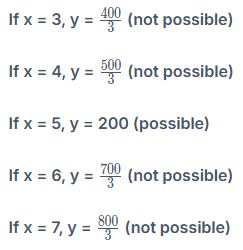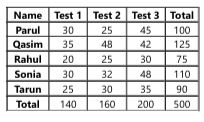The combined ratio of total marks of five students in English for the last three tests can be calculated as follows,
Sonia : Tarun = 11 : 9 = 22 : 18 Rahul : Sonia = 15 : 22
Qasim : Rahul = 5 : 3 = 25 : 15
Parul : Qasim = 4 : 5 = 20 : 25
So, Parul : Qasim : Rahul : Sonia : Tarun = 20 : 25 : 15 : 22 : 18
Let total marks of five students in English for last three tests = 100x Parul = 22x,
Qasim = 25x, Rahul = 15x, Sonia = 22x and Tarun = 18x
Let the total marks scored by the five students in Test 3 = y
So, total marks scored by the five students in Test 2 = y – 40 and in Test 1 = y – 60 So, 3y – 100 = 100x
Given, the maximum marks for each of the test is 50 and no one scored less than 20 marks in any of the tests
So, 300 ≤ 100x ≤ 750 Considering the marks of all the students in each of the three tests as integers,

Thus, total marks of five students for last three tests = 500
Now, let the score of Rahul in Test 1 = a, Test 2 = a + 5 and Test 3 = a + 10
Solving, a + a + 5 + a + 10 = 75 => a = 20
Similarly, let the score of Tarun in Test 1 = b, Test 2 = b + 5 and Test 3 = b + 10
Solving, b + b + 5 + b + 10 = 90 => b = 25
The marks scored by Parul and Sonia each in Test 1 = 1.2 × 25 = 30
Let Sonia’s marks in Test 2 = 2c and Test 3 = 3c
Solving, 30 + 2c + 3c = 110 => c = 16
Also, Qasim’s marks in Test 1 = 140 – (30 + 20 + 30 + 25) = 35
Let Qasim’s marks in Test 2 = 8d and Test 3 = 7d
Solving, 35 + 8d + 7d = 125 => d = 6
Similarly, Parul’s marks in Test 2 = 160 – (48 + 25 + 32 + 30) = 25
And,
Parul’s marks in Test 3 = 200 – (42 + 30 + 48 + 35) = 45
The rest of the information can be gathered as follows

50% weightage scores from tests 1, 2 and 3
Parul = 10% of 30 + 15% of 25 + 25% of 45 = 18
Qasim = 10% of 35 + 15% of 48 + 25% of 42 = 21.2
Sonia = 10% of 30 + 15% of 32 + 25% of 48 = 19.8
Tarun = 10% of 25 + 15% of 30 + 25% of 35 = 15.75
Sonia scored the maximum marks in Test 3 = 48


 Get latest Exam Updates
Get latest Exam Updates 
 ×
×
















